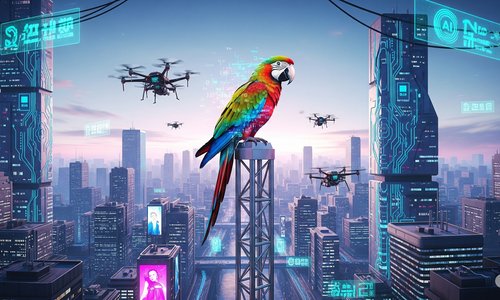
A Promessa e o Perigo da Nova Revolução Digital
A nova corrida tecnológica global levanta uma pergunta urgente: estamos prontos para confiar na inteligência que criamos?

O anúncio de que o Grok-1 da xAI agora é completamente Open Source, liberando tanto código quanto pesos sob a licença Apache 2.0, representa um marco significativo no mundo da Inteligência Artificial (IA). Com seus 314 bilhões de parâmetros, o Grok-1 não apenas se destaca como o maior modelo de Mixture-of-Experts disponibilizado abertamente até a data, mas também sinaliza um momento potencialmente transformador para o campo da IA.
Desenvolvedores e pesquisadores agora têm acesso inédito a um Modelo de Linguagem Grande (LLM) de última geração, que promete democratizar as capacidades de IA, anteriormente guardadas a sete chaves por entidades como a OpenAI. Esta acessibilidade tem o potencial de acelerar o desenvolvimento de aplicações personalizadas, desde análises de texto avançadas até sistemas interativos que podem conversar, compreender e reagir em tempo real às necessidades humanas.
Ao contrário de outros modelos significantes, como o GPT-4, que são mantidos fechados, limitando a capacidade de personalização e inovação, o Grok-1 oferece uma tela em branco. Isso não apenas capacita os programadores a adaptar o modelo para aplicações nichadas, mas também abre as portas para melhorias incrementais na própria arquitetura do modelo. Sejam ajustes na maneira como o modelo lida com linguagem natural, seja a integração de novos conjuntos de dados para treinamento, a comunidade agora pode contribuir ativamente para o avanço do Grok-1.
Uma comparação interessante é imaginar o Grok-1 como uma fotografia digital e os modelos de código fechado como fotografias impressas. Tendo acesso ao código e aos pesos do Grok-1, desenvolvedores podem "modificar" o modelo, adaptando-o para agir de formas novas ou preparando-o para desempenhar funções particulares, por exemplo, a interpretação de documentos médicos em sueco.
A decisão de Elon Musk de abrir o código do Grok, em meio a uma rivalidade cada vez mais pública com a OpenAI, reflete não apenas uma estratégia de negócios, mas também uma filosofia de desenvolvimento de IA. Ao promover uma abordagem mais aberta e colaborativa, Musk desafia o status quo, potencialmente estimulando uma inovação mais rápida e diversificada no campo da IA.
Além disso, ao tornar o Grok-1 open-source, Musk e a xAI não apenas oferecem uma ferramenta poderosa para a comunidade de desenvolvimento, mas também lançam um convite para a co- criação. Isso pode acelerar a pesquisa e o desenvolvimento de IA de maneiras que ainda não podemos prever, à medida que mais mentes se juntam ao esforço de explorar e expandir os limites do que a IA pode fazer.
Por outro lado, a abertura do Grok-1 também levanta questões importantes sobre segurança, ética e uso responsável da IA. A ausência de diretrizes claras e o potencial para uso indevido requerem uma discussão contínua e a formação de uma comunidade vigilante e ética em torno do Grok-1. O desenvolvimento futuro do modelo dependerá não apenas da inovação técnica, mas também da capacidade da comunidade de estabelecer normas e práticas que garantam o uso benéfico e ético da tecnologia.
Em última análise, a liberação do Grok-1 como open-source é um momento definidor para o futuro da IA. Ele oferece uma oportunidade sem precedentes para avançar na pesquisa e no desenvolvimento de forma colaborativa e aberta. No entanto, também coloca em destaque a necessidade de uma gestão cuidadosa e responsável do poder que tal tecnologia carrega. À medida que exploramos as possibilidades que o Grok-1 abre, devemos também nos comprometer a fazer isso de maneira que beneficie a sociedade como um todo, garantindo que a IA permaneça uma força para o bem.
Mas nem tudo é flores, para executar o Grok exige recursos de hardware substanciais. Abaixo está uma visão geral dos requisitos de hardware necessário:
GPUs: LLMs dessa escala normalmente requerem várias GPUs de última geração para lidar com a carga computacional. Você provavelmente precisaria de pelo menos 8-16 GPUs com um mínimo de 32-40-80 GB de VRAM cada, como GPUs NVIDIA A100 ou H100. Essas GPUs precisariam ser interconectadas usando interconexões de alta largura de banda, como NVLink ou NVSwitch.
CPU: É necessário uma CPU poderosa ou várias CPUs para lidar com pré-processamento de dados, operações de entrada/saída e outras tarefas auxiliares. Uma CPU moderna de nível de servidor com pelo menos 32 núcleos e 64 threads seria recomendada, como processadores AMD EPYC ou Intel Xeon Scalable.
Memória (RAM): Com 314 bilhões de parâmetros e um tamanho de embedding de 6.144, você precisaria de uma quantidade significativa de RAM para armazenar os pesos do modelo e as ativações intermediárias. Dependendo da implementação específica e das técnicas de otimização, você pode precisar de pelo menos 1-2 TB de RAM DDR4 ou DDR5 de alto desempenho.
Disco: É imprescindível um sistema de armazenamento de alta velocidade, como SSDs NVMe ou um sistema de arquivos distribuído, para armazenar os pontos de verificação do modelo e os dados. Devemos planejar pelo menos vários terabytes de armazenamento.
Rede: Se desejamos distribuir o modelo por várias GPUs ou máquinas, precisaria de uma infraestrutura de rede de alta velocidade, como Ethernet de 100 Gbps ou InfiniBand, para facilitar a comunicação entre os dispositivos.
Energia e resfriamento: Executar várias GPUs e CPUs de última geração gerará uma quantidade significativa de calor, portanto, você precisaria de uma fonte de alimentação robusta e sistema de resfriamento para garantir uma operação estável.
Resumidamente, executar um LLM dessa escala é um empreendimento significativo e provavelmente exigiria um cluster de computação de alto desempenho (HPC) dedicado ou uma solução baseada em nuvem de provedores como AWS, Google Cloud ou Microsoft Azure. Além disso, você pode precisar considerar técnicas como paralelismo de modelo, paralelismo de tensor ou paralelismo de pipeline para distribuir a carga de trabalho em vários dispositivos com eficiência.
Sócio cofundador da empresa OITI TECHNOLOGIES, Pesquisador cujo primeiro contato com tecnologia foi em 1983 com 11 anos de idade. Leva o Linux a sério, pesquisa e trabalhos com biometria e visão computacional desde 1998. Experiência com biometria facial desde 2003, redes neurais artificiais e neurotecnologia desde 2009. Inventor da tecnologia CERTIFACE, mais de 100 palestras ministradas, 14 artigos impressos publicados, mais de 8 milhões de acessos nos 120 artigos publicados, Docente da FIA, Membro oficial Mozillians, Membro oficial e Embaixador OpenSUSE Linux América Latina, Membro do Conselho OWASP SP, Contribuidor da biblioteca OpenCV e Global Oficial OneAPI Innovator Intel, Membro Notável I2AI, Fundador da iniciativa Global openSUSE Linux INNOVATOR e Mentor Cybersecuritygirls BR

A nova corrida tecnológica global levanta uma pergunta urgente: estamos prontos para confiar na inteligência que criamos?

Por que dominar a IA será a nova alfabetização do século XXI

Conselhos de Administração devem evoluir da supervisão reativa para a antecipação estratégica, frente à crescente complexidade e volatilidade dos ambientes de negócios.

De 14 a 25 de julho, reserve suas manhãs das 08h00 às 09h30 para participar da tradicional Maratona I2AI! Uma jornada intensa com debates e palestras sobre temas essenciais: Ética,